Click on images to enlarge
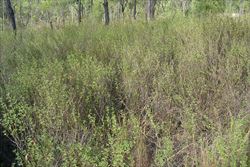
large infestation (Photo: Chris Gardiner)
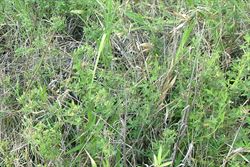
habit (Photo: Sheldon Navie)
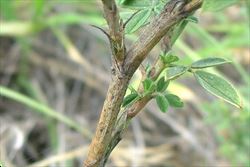
older woody stem (Photo: Sheldon Navie)
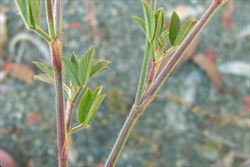
younger stems densely covered in soft hairs (Photo: Sheldon Navie)
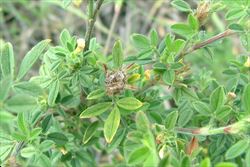
leaves with three leaflets (Photo: Sheldon Navie)
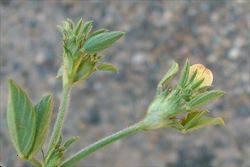
flower clusters and leaf undersides (Photo: Sheldon Navie)
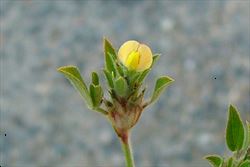
close-up of small pea-shaped flower (Photo: Sheldon Navie)
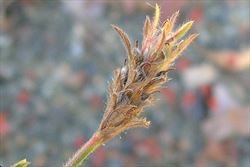
slightly elongated old flower cluster with mature fruit (Photo: Sheldon Navie)
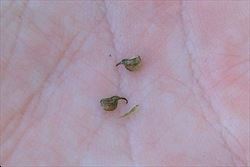
close-up of mature fruit with a small curved beak (Photo: Sheldon Navie)
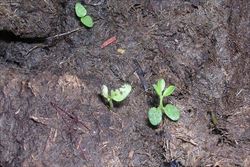
seedlings emerging from cow dung (Photo: Chris Gardiner)
Scientific Name
Stylosanthes scabra Vogel
Family
Fabaceae (Queensland, the ACT, Victoria, Tasmania, and the Northern Territory)Fabaceae: sub-family Faboideae (New South Wales)Leguminosae (South Australia)Papilionaceae (Western Australia)
Common Names
pencilflower, seca, seca stylo, shrubby stylo
Origin
Native to the Caribbean (i.e. the Bahamas and Cuba) and South America (i.e. Guyana, Venezuela, Brazil, Bolivia, Colombia, Ecuador and Argentina).
Cultivation
Widely cultivated as a pasture legume in the warmer parts of Australia. 'Seca' is the most common and well known of the cultivars that are grown in this country.
Naturalised Distribution
Widely naturalised in northern Australia (i.e. in northern and eastern Queensland, in the northern parts of the Northern Territory, and in northern Western Australia).
Also naturalised overseas in Hawaii.
Habitat
A weed of open woodlands, grasslands, floodplains, levee banks, roadsides, disturbed sites, waste areas and crops in tropical and sub-tropical regions.
Habit
An upright (i.e. erect) woody herbaceous plant or small shrub growing 0.3-2 m tall.
Distinguishing Features
- an upright small woody shrub growing 0.3-2 m tall.
- its stems are covered with short hairs, some of which are sticky.
- its compound leaves consist of three leaflets (16-25 mm long and 3.5-9 mm wide).
- its small pea-shaped flowers are predominantly yellow with reddish centres.
- its small fruit (8-9.5 mm long) separates into two segments and is topped with a small hooked beak (1.5-2 mm long).
Stems and Leaves
The woody stems are covered with short hairs (i.e. they are pubescent), some of which are often sticky (i.e. glandular). Younger stems vary from pale green to brown or reddish in colour, while older stems are brown or greyish.
The alternately arranged leaves are compound and consist of three leaflets (i.e. they are trifoliate). These leaves each have two toothed leafy structures (i.e. stipules) 15 to 25 mm long at their bases, and are borne on stalks (i.e. petioles) 5-20 mm long. The leaflets are oval (i.e. elliptic), egg-shaped (i.e. ovate) in outline, or somewhat elongated in shape (i.e. oblong-lanceolate) with entire margins and pointed or rounded tips (i.e. acute to obtuse apices). These leaflets (16-25 mm long and 3.5-9 mm wide) are loosely covered in hairs on both surfaces, some of which are sticky (i.e. glandular).
Flowers and Fruit
The small pea-shaped flowers are borne in short and dense spikes in the upper leaf forks. These stalkless (i.e. sessile) flowers are predominantly yellow (occasionally cream or pale yellow) with reddish centres. They have five sepals (4-6 mm long) that are joined together at the base (i.e. into a calyx tube) and five petals (3-6 mm long). The uppermost petal (i.e. standard) is larger than the two side petals (i.e. lateral or wing petals). The two lower petals are joined together and folded (i.e. into the keel). Flowers also have ten small stamens, which are fused to each other, and an ovary topped with a style and stigma.
The small fruit (8-9.5 mm long and 2-2.5 mm wide) is a pod that separates into two segments (i.e. a lomentum). These fruit are hairy (i.e. pubescent) and topped with a small hooked beak (1.5-2 mm long). They contain light brown seeds (up to 2 mm long) that are somewhat kidney-shaped (i.e. reniform).
Reproduction and Dispersal
This species reproduces by seed. These seeds are dispersed by livestock and other animals movement, as a contaminant of hay, and by vehicles and machinery (e.g. slashers and graders).
Environmental Impact
Shrubby stylo (Stylosanthes scabra) is regarded as an environmental weed in Queensland, the Northern Territory and northern Western Australia.
Legislation
Not declared or considered noxious by any state government authorities.
Similar Species
Shrubby stylo (Stylosanthes scabra) is very similar to common stylo (Stylosanthes guianensis), sticky stylo (Stylosanthes viscosa), Caribbean stylo (Stylosanthes hamata) and Townsville stylo (Stylosanthes humilis). These species can be distinguished by the following differences:
- Shrubby stylo (Stylosanthes scabra) is a relatively upright (i.e. erect) shrubby plant growing 0.3-2 m tall. Its stems are densely covered in soft hairs, some of which are sticky (i.e. glandular). Its small fruit are somewhat hairy (i.e. pubescent) and are topped with a short hook (1.5-2 mm long).
- common stylo (Stylosanthes guianensis) is a relatively upright (i.e. erect) shrubby plant growing 0.5-1.5 m tall. Its stems are covered in short soft hairs as well as stiff yellow or reddish bristly hairs. Its small fruit are hairless (i.e. glabrous) and are topped with a very inconspicuous hook (less than 1 mm long).
- sticky stylo (Stylosanthes viscosa) is a low-growing to relatively upright (i.e. erect) plant growing up to 0.8 m tall. Its stems are densely covered in sticky (i.e. glandular) hairs. Its small fruit are are hairless (i.e. glabrous) and are topped with a very inconspicuous hook (less than 1 mm long).
- Caribbean stylo (Stylosanthes hamata) is a low-growing (i.e. prostrate or decumbent) plant growing up to 0.5 m tall. Its stems are partially covered in small soft hairs. Its small fruit are sparsely hairy (i.e. sparsely pubescent) and are topped with a long hook (about 4 mm long).
- Townsville stylo (Stylosanthes humilis) is a low-growing (i.e. prostrate or decumbent) plant growing up to 0.4 m tall. Its stems are partially covered in tiny soft hairs, but may appear almost hairless. Its small fruit are sparsely hairy (i.e. sparsely pubescent) and are topped with a very long hook (4-6 mm long).

